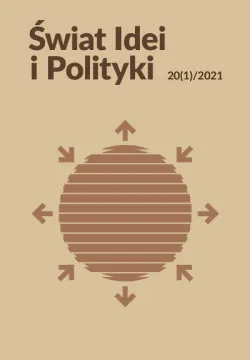Estonian political parties in the struggle for power in the second decade of the 21st century
DOI:
https://doi.org/10.34767/SIIP.2021.01.01Keywords:
Estonian political parties, the second decade of the 21st century, struggle for power, Estonian Reform Party, Estonian Centre Party, Conservative People’s Party of EstoniaAbstract
The article analyzes the evolution of Estonia’s party system in the con-text of the struggle for power in the second decade of the 21st century (the starting point here is Estonia’s entry into the eurozone). Until 2016, the political scene in the Republic of Estonia was dominated by the Estonian Reform Party. At that time, this liberal, pro-market and pro-Western party was forming successive gov-ernment coalitions. The main opposition force was the Estonian Center Party, a populist party that was particularly popular with the country’s large Russian minority. In the fall of 2016, significant changes took place on the political scene of the Republic. The liberals lost the support of the coalition partners who had reached an agreement with the previously opposition Estonian Center Party. Al-though the Estonian Reform Party remained the strongest party in the country, it found itself in opposition. Another characteristic trend was the rise in popu-larity of the eurosceptic Conservative People’s Party of Estonia in the second half of the decade. The 2019 elections were won by the opposition liberal Estonian Reform Party, but failed to build a majority coalition. The Estonian Center Party remained in power, signing a surprising and by many criticized agreement with the Conservative People’s Party of Estonia. However, this coalition turned out to be short-lived. The return of the liberals to power in January 2021 confirmed their unchangingly strong political position for years. Importantly, it took place during the crisis caused by the coronavirus pandemic.References
Auers, D. (2019). Latvia, Lithuania, and Estonia. W:C. Close, E. Van Haute (red.), Liberal parties in Europe (s. 241–258). London: Routledge.
Chmielewski, B. (2021). Od kryzysu do wielkiej koalicji i pierwszej kobiety na czele rządu w Estonii.
Ciechanowska, J., Szwed, K. (2017). Finansowanie partii politycznych w Republice Estonii. Przegląd Prawa Konstytucyjnego, 4, 133–150. DOI: 10.15804/ppk.2017.04.07.
Close, C., Delwit, P. (2019).Liberal parties nad elections. Electoral performances and voters’ profile. W:C. Close, E. Van Haute (red.), Liberal parties in Europe (s. 281–309). London: Routledge.
Dandashly, A., Verdun, A. (2020). Euro adoption policies in the second decade – the remarkable cases of the Baltic States. Journal of European Integration, 42(3), 381–397. DOI: 10.1080/07036337.2020.1730355.
Ehin, P., Talvin, L. (2019). Estonia: A scene set by the preceding national election.
Górny, G. (2019). Estonia – rusofile z rusofobami, czyli najdziwniejsza koalicja rządowa w Europie.
Hartleb, F. (2019). The far right in power in Estonia. A crisis of values or democracy?
Hääletamisest osavõtu statistika (2015).
Hyndle-Hussein, J. (2014). Premier Estonii Andrus Ansip rezygnuje.
Hyndle-Hussein, J. (2015a). Estonia nowelizuje ustawę o obywatelstwie.
Hyndle-Hussein, J. (2015b). Państwa bałtyckie wobec konfliktu na Ukrainie.
Hyndle-Hussein, J. (2015c). Wybory parlamentarne w Estonii.
Hyndle-Hussein, J. (2016a). Estonia bez nowego prezydenta.
Hyndle-Hussein, J. (2016b). Estonia: upadek rządu Rõivasa i koniec izolacji Partii Centrum.
Hyndle-Hussein, J. (2016c). Nowy rząd w Estonii.
Hyndle-Hussein, J. (2019a). Estonia: nacjonaliści w rządzie Jüriego Ratasa.
Hyndle-Hussein, J. (2019b). Estonia: powrót do władzy liberalnej Partii Reform.
Hyndle-Hussein, J. (2021). Nowy rząd w Estonii: powrót liberałów.
Jagusiak, B. (2013). Systemy polityczne krajów nadbałtyckich. Warszawa: Difin.
Kök ker,P. (2019).The effects of majority requirements, selectorate composition and un-certainty in indirect presidential elections: the case of Estonia. East European Politcs, 35, 238–258. DOI: 10.1080/21599165.2019.1604339.
Konończuk, W. (2007). Walka o pamięć. Rosyjsko-estoński kryzys wokół „Żołnierza z brązu”. Nowe Sprawy Polityczne, 33, 51–59.
Konstytucja Republiki Estońskiej(2011). W: W. Staśkiewicz (red.), Konstytucje państw Unii Europejskiej (s. 229–247). Warszawa: Wydawnictwo Sejmowe.
Kubiniec, W. (2011). System partyjny Estonii. W: B. Kosowska-Gąstoł (red.), Systemy partyjne państw Unii Europejskiej (s. 97–109). Kraków: Wydawnictwo Uniwersytetu Jagiellońskiego.
Kund, O. (2015). EKRE – from club status to parliament rank.
Kuusik, P. (2019). Estonian parliamnetary election 2019: open and progressive Estonia marches on.
Lanko, D. (2015). Estonian political parties in the mid-2010s. Baltic Region, 2, 50–57. DOI: 10.5922/2079–8555–2015–2-5
Lindstrom, N. (2015). The politics of Europeanization and post-socialist transformations. New York: Palgrave Macmillan.
Nelson, J.P. (2015). Estonia’s obligation to its stateless population. Michigan Journal of International Law, 37.
Otocki, T. (2019). Kaja Kallas: rząd Ratasa niszczy reputację międzynarodową Estonii.
Petsinis, V. (2019). Identity politics and right-wing populism in Estonia: the case of EKRE. Nationalism and Ethnic Politics, 25, 211–230. DOI: 10.1080/13537113.2019.1602374.
Popławski, K. (2015a). Edgar tańczy na lodzie, czyli wzloty i upadki Edgara Savisaara.
Popławski, K. (2015b). Jak Estończycy powiedzieli NIE dla partii prorosyjskiej.
Popławski, K. (2016a). Jüri Ratas nowym Estońskiej Partii Centrum.
Popławski, K. (2016b). Kersti Kaljulaid – pierwsza kobieta prezydent Estonii.
Popławski, K. (2016c). Wszystkie zwycięstwa Jüriego Ratasa. Nowy premier i rząd Estonii.
Siarkiewicz, P. (2011a). Estonia w strefie euro – sukces strategiczny.
Siarkiewicz, P. (2011b). Rządząca centroprawica wygrywa wybory parlamentarne w Estonii.
Sikk, A. (2006). From private organizations to democratic infrastructure. Political parties nad the state in Estonia. Journal of Communist Studies and Transition Politics, 22(3), 341–361. DOI: 10.1080/13523270600855720.
Sikk, A. (2011). Estonia. European Journal of Political Research,50, 960–964.
Sikk, A. (2015a). Estonia. European Journal of Political Research,54, 94–100.
Sikk, A. (2015b). Estonia’s 2015 election result ensures the Reform Party will continue to dominate the country’s politics.
Trumm, S. (2018). The „new” wave of populist right-wing parties in Central and Eastern Europe. Explaining electoral support for the Conservative People’s Party of Estonia.
Włodarska-Frykowska, A. (2017). Mniejszość rosyjska w życiu społeczno-politycznym Esto-nii po 1991 roku. Łódź: Wydawnictwo Uniwersytetu Łódzkiego.
Downloads
Published
Issue
Section
License

This work is licensed under a Creative Commons Attribution-NonCommercial-NoDerivatives 4.0 International License.

